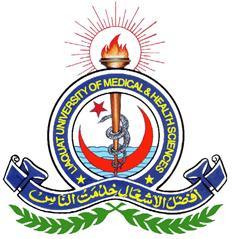Ultrasound Findings in Adult Patients with Chronic Shoulder Pain Having No History of Trauma
Keywords:
Shoulder pain, Impingement syndrome, Rotator Cuff Tears, Tenosynovitis, Ultrasound shoulderAbstract
OBJECTIVE: To evaluate the frequency of non-traumatic chronic shoulder pain sonographically in the local population.
METHODOLOGY: This cross-sectional study was conducted at the Department of Radiology, Combined Military Hospital Malir, from March to October 2020. A history of shoulder pain of more than one-month duration was included. Patients with a History of shoulder dislocation, neurological, renal, hepatic and cardiac diseases were excluded. The sample size was 196. A non-probability consecutive sampling technique was employed. SPSS version 23 was used for statistical analysis.
RESULTS: 196 patients (69.9% males and 30.1% females) with non-traumatic shoulder pain (56.4 % right side and 43.4% left) were scanned. The mean age was 42.80±11.20 years. Out of 196, 118(60.2%) were having complaints in dominant limbs (right 51.0% and left 9.2%); 78(39.8%) were having pain in non-dominant limbs (right 6.6% and left 33.2%). Significant findings were supraspinatus partial tear (46.9%), sub-acromial sub-deltoid bursitis(8.2%), and biceps tenosynovitis(6.1%), adhesive capsulitis, a complete tear of supraspinatus tendon, impingement syndrome, joint effusion, subscapularis tendon tear and tenosynovitis. 44(22.4%) patients had two pathologies, and 31 (15.8%) patients had three pathologies, respectively. Significant co-existent findings were biceps tenosynovitis (13.8%), Impingement syndrome (9.2%), bursitis (8.2%) and joint effusion (7.1%). Age and number of pathological were moderately positively correlated, r (194) = 0.46, p < 0.01 and keeping CI = 95%.
CONCLUSION: Partial tears of the supraspinatus tendon were the most common pathology in non-traumatic shoulder myalgia, diagnosed on ultrasound, followed by sub-acromial sub-deltoid bursitis and biceps tenosynovitis, having moderate linear relation with age.
References
Djade CD, Porgo TV, Zomahoun HTV, Perrault?Sullivan G, Dionne CE. Incidence of shoulder pain in 40 years old and over and associated factors: A systematic review. Eur J Pain. 2020; 24(1): 39-50. doi: 10.1002/ejp.1482. Epub 2019 Oct 13.
Brox JI, Sunde P, Schroder C, Engebretsen K, Skare O, Ekeberg OM. Non-traumatic shoulder pain. Tidsskrift Nor Praktisk Medicin, NY Raekke. 2010; 130(21): 2132-5. doi: 10.4045/tidsskr.09.1083.
Naqvi GA, Jadaan M, Harrington P. Accuracy of ultrasonography and magnetic resonance imaging for detection of full-thickness rotator cuff tears. Int J Shoulder Surg. 2009; 3(4): 94-7. doi: 10.4103/0973-6042.63218.
Okoroha KR, Fidai MS, Tramer JS, Davis KD, Kolowich PA. Diagnostic accuracy of ultrasound for rotator cuff tears. Ultrasonography. 2019; 38(3): 215-220. doi: 10.14366/usg.18058.
Janeiro J, Barreira SC, Martins P, Ninitas P, Campos J, Fonseca JE. Ultrasound Features Associated With Shoulder Complaints: Calcifications Larger Than 6 mm in Young Patients and Positive Doppler Are Associated With Pain. Front Med(Lausanne). 2021; 8: 715423. doi: 10.3389/fmed.2021.715423.
Mahajan A, Tobase P, Phelps A, Phelan D, Lesh MB, Giermasz A. Radiologist-performed musculoskeletal ultrasound (MSKUS) for evaluation of joint and soft tissue pain episodes in patients with bleeding disorders. Blood. 2015; 126(23): 3266. doi: 10.1182/blood.V126.23.3266.3266.
Khan MSZ, Rahman N, Ferdousi MA, Khatoon R, Taher MA. Ultrasonographic findings in patients with shoulder pain. BIRDEM Med J. 2019; 9(3): 218-222. doi: 10.3329/BIRDEM.V9I3.43085
Lewis J. Rotator Cuff-related shoulder pain. Advances in understanding and management. J Sci Med Sport. 2017; 20: 47.
Salek KM, Mannan M, Chowdhury AZ, Haque MA, Kaiser MS, Nabi S et al. Comparison between ultrasound and plain X-ray in evaluating the cause of shoulder pain. Mymensingh Med J. 2011; 20(1): 16-21.
Sconfienza LM, Albano D, Allen G, bazzocchi A, Bignotti B, Cianca V et al. Clinical indications for musculoskeletal ultrasound updated in 2017 by European Society of Musculoskeletal Radiology (ESSR) consensus. Eur Radiol. 2018; 28(12): 5338-5351. doi: 10.1007/s00330-018-5474-3. Epub 2018 Jun 6.
Martinoli C. Musculoskeletal ultrasound: technical guidelines. Insights Imaging. 2010; 1(3): 99-141. doi: 10.1007/ s13244-010-0032-9.
Tamborrini G, Bianchi S. Ultrasound of the Shoulder (Adapted According to SGUM Guidelines). Praxis[Bern 1994]. 2020; 109(7): 521-530. doi: 10.1024/1661-8157/a003470.
Mohtasib RS, Alzahrani AM, Asiri YN, Rayes ZF, Alshaalan MA. Accuracy of shoulder ultrasound examination for diagnosis of rotator cuff pathologies: a single-centre retrospective study. Ann Saudi Med. 2019; 39(3): 162-171. doi: 10.5144/0256-4947.2019.162.
Gupta P, Uppal S, Achuthan K, Adya C, Singh A, Saini J. Sonography: a valuable modality in evaluation of chronic non-traumatic disorders of the shoulder joint. Med J Armed Forces India. 1998; 54(1): 27-31. doi: 10.1016/S0377-1237 (17)30402-1. Epub 2017 Jun 26.
Singh AP, Rao A, Devaru S, Amithavikrama. Role of Ultrasound in Evaluation of Shoulder Injuries: A Comparative Study of Ultrasound and MRI. Int J Anatomy Radiol surgery. 2017; 6(1): R012-R018. doi: 10.7860/IJARS/2017/ 24542:2224.
Saraya S, El Bakry R. Ultrasound: can it replace MRI in the evaluation of the rotator cuff tears? Egypt J Radiol Nuclear Med. 2016; 47(1): 193-201.
Papatheodorou A, Ellinas P, Takis F, Tsanis A, Maris I, Batakis N. US of the shoulder: rotator cuff and non–rotator cuff disorders. Radiographics. 2006; 26(1): e23. doi: 10.1148/rg.e23.
Zheng F, Wang H, Gong H, Fan H, Zhang K, Du L. Role of ultrasound in the detection of rotator-cuff syndrome: an observational study. Med Sci Monit. 2019; 25: 5856. doi: 10.12659/MSM.915547.
Sconfienza LM, Adriaensen M, Albano D, allen G, Gomez MP, Bazzocchi A et al. Clinical indications for image-guided interventional procedures in the musculoskeletal system: a Delphi-based consensus paper from the European Society of Musculoskeletal Radiology (ESSR)—part I, shoulder. Eur Radiol. 2020; 30(2): 903-913. doi: 10.1007/s00330-019-06419-x. Epub 2019 Sep 16.
Chang K-V, Mezian K, Na?ka O, Wu W-T, Lin C-P, Özçakar L. Ultrasound-guided interventions for painful shoulder: from anatomy to evidence. J Pain Res. 2018; 11: 2311-2322. doi: 10.2147/JPR.S169434.
Lagnocco A, Coari G, Leone A, Valesini G. Sonographic study of painful shoulder. Clin Exp Rheumatol. 2003; 21(3): 355-8.
Naredo E, Aguado P, De Miguel E, Usan J, Mayordomo L, Gijon-Banos J et al. Painful shoulder: comparison of physical examination and ultrasonographic findings. Ann Rheumatic Dis. 2002; 61(2): 132-136. doi: 10.1136/ard. 61.2.132.
Jiang L, He J, Chen CP, Xie D, Mai Y, Yue B et al. The Ultrasonographic Features of Shoulder Pain Patients in a Tertiary Hospital in South China. Biomed Res Int. 2020; 2020: 3024793. doi: 10.1155/2020/3024793.
Ottenheijm RP, van’t Klooster IG, Starmans LM, Vanderdood K, de Bie RA, Dinant G et al. Ultrasound-diagnosed disorders in shoulder patients in daily general practice: a retrospective observational study. BMC Fam Pract. 2014; 15: 115. doi: 10.1186/1471-2296-15-115.
Farooqi AS, Lee A, Novikov D, Kelly AM, Li X, Kelly 4th JD et al. Diagnostic accuracy of ultrasonography for rotator cuff tears: a systematic review and meta-analysis. Orthop J Sports Med. 2021; 9(10): 23259671211035106. doi: 10.1177/23259671211035106.
Downloads
Published
How to Cite
Issue
Section
License
Copyright (c) 2023 Journal of Liaquat University of Medical & Health Sciences

This work is licensed under a Creative Commons Attribution-NonCommercial-ShareAlike 4.0 International License.
Submission of a manuscript to the journal implies that all authors have read and agreed to the content of the undertaking form or the Terms and Conditions.
When an article is accepted for publication, the author(s) retain the copyright and are required to grant the publisher the right of first publication and other non-exclusive publishing rights to JLUMHS.
Articles published in the Journal of Liaquat University of Medical & health sciences are open access articles under a Creative Commons Attribution-Noncommercial - Share Alike 4.0 License. This license permits use, distribution and reproduction in any medium; provided the original work is properly cited and initial publication in this journal. This is in accordance with the BOAI definition of open access. In addition to that users are allowed to remix, tweak and build upon the work non-commercially as long as appropriate credit is given and the new creations are licensed under the identical terms. Or, in certain cases it can be stated that all articles and content there in are published under creative commons license unless stated otherwise.























